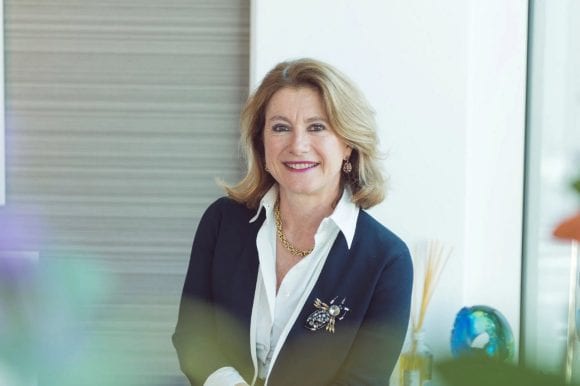Meet our clients Corinne’s story
The jazz route to roads and riches

How our client Corinne Vigreux went from creating the world's first navigation device to mapping the world in real time

Corinne Vigreux
Co-Founder, TomTom
Netherlands
Corinne Vigreux, co-founder of the Dutch virtual mapmaker TomTom that twenty years ago revolutionized the driving experience, is rapid-fire “riffing” in her office in Amsterdam. Her slow-witted guest is listening hard, but her mind and speech are moving so fast – about Big Data and mobility and real-time traffic rerouting – he’s having trouble keeping up.
But then there are those sublime moments when it all comes together. In 2004, TomTom famously launched GO, its dashboard-mounted satellite car navigation system that instantly became a consumer-electronics sensation. TomTom picked up a million clients within a year of launch, and promptly capitalized by going public in 2005. TomTom’s valuation hit a high just shy of $11 billion. By 2006, however, there were 30 competitors making personal navigation devices, and by 2007, Google Maps was available for free on mobile phones.
That’s when TomTom should have wound up as roadkill. But Vigreux and her TomTom cofounders, which includes her later joining CEO husband Harold Goddijn, were always on the lookout for what was around the corner. They knew that having a hot tech consumer product was a short-lived business – there was always a new and better technology coming up in the fast lane – and their clients, at this point some major car manufactures, were expressing demand for continuous road and map updates. At the time, map updating was a lumbering process that occurred just a couple of times a year.
So, starting already back in 2005, Vigreux and her partners returned to their software roots and used TomTom’s high paper value to map out their future. They first acquired a web-based logistics system that tracked fleets of vehicles; then a technology that provided real-time traffic information gleaned from cellphone networks; before finally adding a sophisticated digital mapmaker. Today, TomTom is largely out of the consumer-electronics business and primarily an independent business-to-business mapmaker for the likes of Fiat Chrysler and Hyundai Motor Group, while also providing high-end mapping services for Uber, Apple, and Microsoft. With partner Volkswagen, meanwhile, TomTom is working on the HD maps and AI that will be at the heart of the autonomous-driving vehicles of the future.
Vigreux and her partners returned to their software roots and used TomTom’s high paper value to map out their future
“I think what's characterized TomTom is that we've always done one thing, which was have a problem-solving mind set. We haven't done technology for technology’s sake. We've always asked, ‘how can we solve that problem?’ The technology will always catch up with us, and when it did, we wanted to be ready.”
Vigreux’s rapid-fire speech and her run of interesting tangential thoughts, before returning to the main theme, reminds us of a world-class jazz musician jamming with peers. Perhaps there is reason for this. Vigreux was born “on the wrong side of the tracks” in a working-class neighborhood of Lyon – her father bought supplies for a chemicals company, her mother was a pharmacy dispenser – but the Vigreux were also “very different from the other families in the area.” That’s because, she says, “education was everything” in her parents’ household. Her father revered books, took her to museums, made sure she was weaned on Thelonious Monk and Miles Davis. “We had jazz on all the time in the house,” she says.
TomTom is now mapping out its third phase of development. By combining AI with multiple intelligence sources – from on-the-ground crowdsourcing observations to Big Data traffic information – TomTom is creating a hyper responsive and dynamic map service that Vigreux likens to a digital “canvas.” This next generation map will, in real time, constantly and accurately redirect traffic into alternate routes, continuously moving cars and trucks around traffic jams and sending them efficiently on to their final destination. The data coordination required to create this dynamic map is so massive that late last year TomTom co-founded the Overture Foundation – with Amazon Web Services, Meta, and Microsoft, and under the auspices of the Linux Foundation – to “develop interoperable open map data.”
By combining AI with multiple intelligence sources TomTom is creating a hyper responsive and dynamic map service.
This real-time map is much needed because more and more cars are coming on to the roads, road networks are altered at a 10% to 15% rate every year, and Climate Change increasingly demands we become more efficient travelers. Building such a reliable real-time mapping service on a mass scale is of course a hugely expensive proposition, but TomTom is betting there is room in the market for an independent alternative to Google.
“Our third chapter is about becoming a geolocation company that's incorporating changes to maps in real time, validating them in real time, and broadcasting them in real time. Use cases are humongous, not only for our existing customers – like car hailing or food delivery companies, logistics or fleet management – but for everybody who wants to be mobile.”
How so? Think about how our travel paths are year-on-year becoming ever more congested. In the near future, Vigreux predicts, “anyone who wants to be mobile is going to need this type of real-time data to get around.”
“Anyone who wants to be mobile is going to need this type of real-time data to get around.”
Taking on Google and its $1.5 trillion market cap is a bold ambition for a Dutch company with a 1 billion Euro market cap. But an ability to improvise – both at a moment’s notice and in a farsighted way – is not just a key feature of jazz, or Vigreux’s trill talking style, it’s also at the core of TomTom and why it is still standing today, when so many other tech companies have disappeared without a trace after their initial success. This admirable skillset is in fact why we asked Vigreux to “riff” on where she thinks the great business and investment opportunities are lurking, as we approach the middle of the 21st Century.
Vigreux says that in most places – between Charles de Gaulle Airport and Paris Center, for example – you simply can’t add more roads, while countries like India and China are adding cars to their existing roads at a furious rate. It’s unsustainable. “Our whole thinking about mobility must change,” she says. Vigreux believes we must use everything from remote work to electric bikes to public transport to designing new cities and businesses specifically with mobility in mind to reduce the ever-increasing amounts of time we waste in traffic congestion. Vigreux is intense on this mobility subject. She even urges us to think about “micro-mobility,” the way, for example, we share documents between remote workers.
“Our whole thinking about mobility must change,” she says.
Electric cars (EV) are part of that new thinking, of course, but, in the U.S., they still only account for 1% of the vehicles on the road. That’s because “the [charging] infrastructure is not there yet. It’s complex and fragmented.” Vigreux believes that investors “who can enable and accelerate” the electric-car infrastructure getting built in a smart way, will hit a significant pay day.
That’s not as easy as it sounds. “The problem today is you have a lot of people competing with each other” to get their plug-in systems built. “I think there has to be some grown-up syncing, some consortium work bringing the data together, so that all consumers can get their EVs charged, independent of what car they drive. They must have access to plug-in stations everywhere and be able to choose their provider. So, you want to have some sort of harmonization of the data on that front, all so consumers can have at their fingertips long-distance EV routing and charging information, removing anxieties of travel.”
“There are investments to be made in electric-car infrastructure and the people who crack the code of this are going to make money.”
In other words, governments, however lumbering, must establish the broad framework rules of the electric cars’ infrastructure – so that all consumers’ car choices are honored at a plug-in station and there’s a universal billing system – before unleashing the private sector, which can of course more quickly and efficiently get the infrastructure built.
“It’s still in its infancy,” Vigreux says, “but there are investments to be made in electric-car infrastructure and the people who crack the code of this are going to make money. Even though no one has been successful to date, we know it needs to happen.”
As if on cue, when we went to press with this article, seven car manufacturers – from GM to Mercedes-Benz – announced they were creating a joint venture and coordinating their charge technologies, for the purpose of building 30,000 plug-in stations across North America. Tesla and Ford were, however, conspicuously absent from this coordinated approach.
The views expressed are those of the interviewee, not UBS.
The information in this discussion has been prepared by, and reflects the opinions and various investment views of, the speaker. UBS has not independently verified such information and does not guarantee its accuracy or completeness. This information is being provided to you for your information purposes only and does not constitute a recommendation or an endorsement by UBS of the author, the securities or views stated herein. Any specific securities discussed should not be considered a recommendation or solicitation to buy or sell any particular security. You should not assume that any investment in any of the securities was or will be profitable. Any information presented is general in nature and not intended to provide individually tailored investment advice.
No affiliation, association, sponsorship or endorsement is suggested or implied by UBS to any person, entity, company or organization appearing, featured or mentioned in the interview, although UBS may have or have had a relationship with, or may provide or have provided products and/or services to, certain persons, entities, companies and/or organizations mentioned herein.
© UBS 2023. All rights reserved. UBS AG.
Clients talking purpose
Clients talking purpose
Our UBS purpose is the North Star that guides us and guides others to us. Being close to our clients allows us to present them with ways to navigate volatility and meet their financial goals. At the same time, it allows us to listen to them – and their insights are fascinating.
In an interview series we’re talking to our clients to find out how they are pursuing their purpose. We hope their personal stories and insights inspire you to reimagine how the power of investing and interpersonal connections can help you create a better world; for yourself, for the ones you love, for the planet, and for all.




